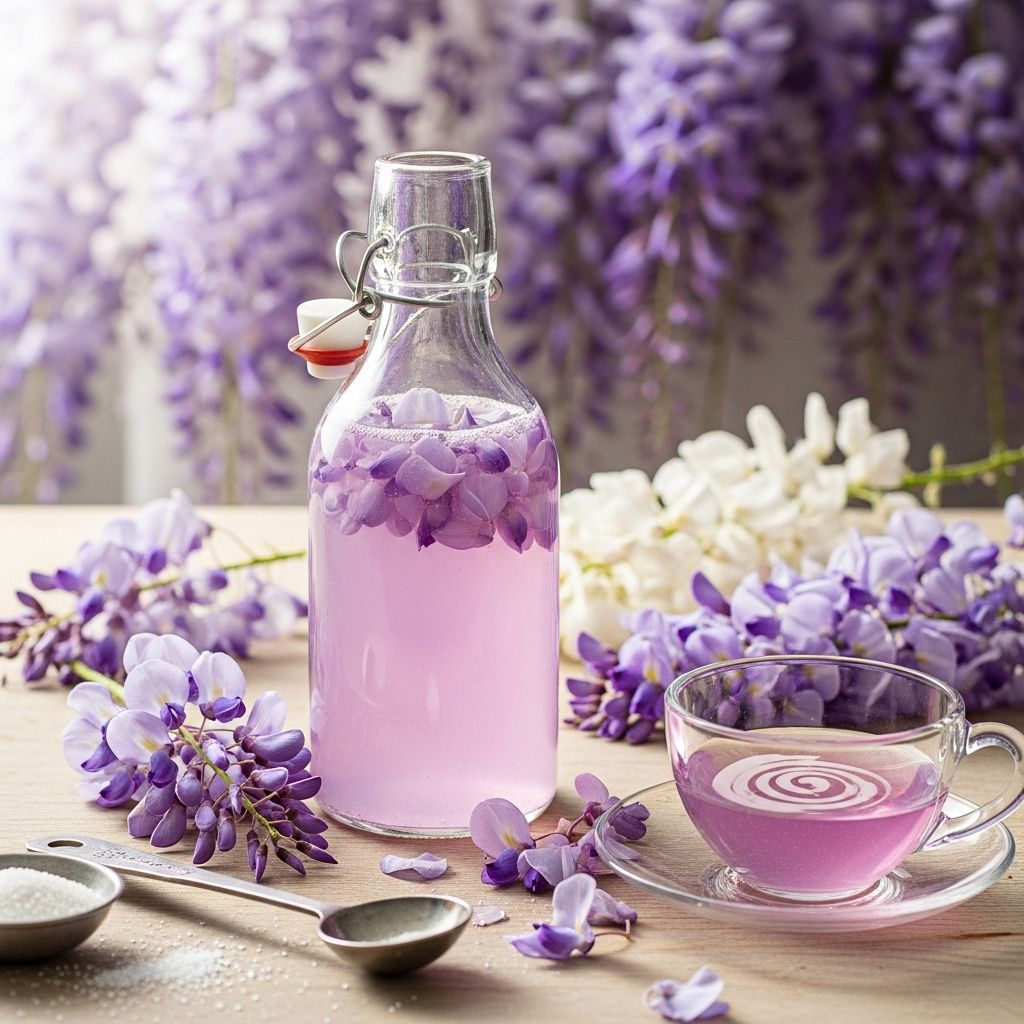Wisteria Syrup: A Step-By-Step Spring Infusion Guide
Transform seasonal blooms into a fragrant syrup that enriches drinks and desserts safely.

Wisteria Syrup: Infusing Spring’s Perfume into Food and Drink
As wisteria vines cloak gardens in cascades of purple, blue, and white blooms, their fragrance fills the air—a sure signal of spring’s return. But beyond their ornamental beauty, wisteria flowers offer a unique, edible opportunity: creating a wisteria syrup that captures and preserves their fleeting aroma. In this article, discover how to bring the perfume of wisteria into your kitchen, how to use the syrup in cocktails, desserts, and especially popsicles, as well as vital safety and foraging advice for handling these blooms.
Wisteria as an Edible Flower: Beauty and Caution
Wisteria (Wisteria sinensis, W. floribunda, and relatives) produces showy, grape-like clusters of lavender, pale-blue, or white blossoms each spring. These flowers are edible, imparting a delicate, sweet fragrance when used in culinary creations, but the plant’s other parts—including pods, seeds, stems, and leaves—are toxic for humans and pets. Only use fully open, unsprayed wisteria flowers and avoid ingesting any green parts.
- Edible part: Fully open wisteria flowers only (avoid green parts and seeds)
- Flavor: Lightly floral, subtly sweet, reminiscent of peas, with an intoxicating spring perfume
- Season: Late spring—harvest when the vines are in full, fragrant bloom
- Safety: All other parts of the wisteria plant are poisonous if ingested
How to Safely Forage Wisteria Flowers
Gather flower clusters from mature, unsprayed vines. Choose blooms that are wide open (not buds), well away from pollution or treated areas. At home, shake flowers to remove insects and carefully separate the blossoms from stems and leaves—discard everything but the petals. There is no need to wash, as doing so may diminish fragrance, but you should visually inspect for any dirt or hitchhiking bugs.
Making Wisteria Syrup: Step-by-Step Recipe
This syrup preserves the springtime aroma of wisteria for use in food and drink all season long. Here’s a simple, effective method tailored for home kitchens.
Ingredients
- 50 g wisteria flowers (stripped from stems and checked for green parts)
- 200 ml water
- 200 g granulated or caster sugar
Note: Yields approximately 2 small bottles. Quantity of wisteria flowers can be slightly more or less; fragrance intensity will vary.
Instructions
- Prepare a small saucepan. Combine sugar and water; heat gently, stirring, until fully dissolved. Bring just to a gentle simmer.
- Add the prepared wisteria flowers and stir. Keep at a very gentle simmer for about 15 minutes.
- Cover with a lid and turn off the heat. Allow to steep for 30 minutes for maximum infusion.
- Strain the syrup through a fine sieve, pressing down with a spoon to extract all the liquid. Discard flowers.
- Pour the syrup into sterilized bottles and cap tightly. Let cool before refrigerating.
Your wisteria syrup will keep for several weeks, refrigerated. For most floral syrups, the flavor is at its best within a month, but refrigerated, it can last much longer.
Tips for Best Results
- Select only freshly opened flowers with strongest scent
- Never combine with stems, buds, leaves, or pods—all are toxic
- If desired, tincture with a small amount of lemon or lime juice to boost tartness and preservation
- Store in clean, sterilized glass containers for best shelf life
Creative Ways to Use Wisteria Syrup
Wisteria syrup’s distinctive aroma and light flavor lend themselves to a range of culinary applications. Below are suggestions to make the most of your floral-infused elixir:
- Drizzle over ice cream, panna cotta, or yogurt for a botanical finish
- Sweeten and flavor sparkling water, lemonade, or cocktails. Pairs beautifully with gin, sake, or vodka
- Create adult popsicles by blending with sake and citrus (see recipe below)
- Brush onto sponge cake or scones as a delicate floral syrup
- Incorporate in fruit salads for an aromatic twist
- Mix into mocktails or teas for gentle sweetness
Recipe Highlight: Wisteria, Lime, and Sake Popsicles
Turn wisteria syrup into a show-stopping dessert pop, perfect for summer gatherings. Inspired by wild-foraged cuisine, this recipe is vibrant, elegant, and refreshingly adult.
Ingredients
- 1 cup chilled Nigori sake (or other cloudy sake)
- ½ cup cold concentrated wisteria syrup
- ½ cup cold lime or lemon juice
- ¼ ounce wisteria flowers, optional for garnish
Instructions
- Combine sake, wisteria syrup, and lime juice in a mixing jug. Taste—it should be sweet-tart, with floral notes. Adjust syrup or citrus for balance.
- If garnishing with flowers, drop a few blossoms into popsicle molds.
- Fill molds one-quarter full, then place in the freezer for two hours.
- Add more flowers and more mixture; freeze another hour. Repeat layering flowers and liquid until molds are full. Insert popsicle sticks as you go.
- Freeze solid. To unmold, briefly dip popsicle molds in warm water. Unmold and enjoy a fragrant, floral ice treat.
Foraged Cuisine: Other Edible Flower Inspirations
The edible flower trend extends well beyond wisteria. Explore these springtime blossoms for an array of colors and fragrances in your kitchen:
- Black Locust flowers: Infused in wine, cordials, and desserts
- Elderflowers: Iconic in cordials, syrups, and fritters
- Cornelian Cherry: Used for jams and syrups throughout Europe
- Muscari (Grape Hyacinth): Aromatic when cooked, added to breads and salads (note: never use common hyacinths, which are toxic)
Many of these flowers, including wisteria, infuse well in both vinegars and syrups. The annual making of wisteria syrup has become a celebration for adventurous cooks and foragers, capturing the brief window of scent when these blossoms are at their peak.
Table: Edible Parts vs. Toxic Parts of Wisteria
| Plant Part | Edible? | Notes |
|---|---|---|
| Flowers (fully open) | Yes | Fragrant, use only petals |
| Leaves | No | Toxic if ingested |
| Stems | No | Toxic |
| Seed pods/seeds | No | Highly toxic |
| Buds (unopened flowers) | No | Lack fragrance, may be bitter |
Frequently Asked Questions (FAQs)
Q: Are all types of wisteria flowers edible?
A: Yes, but only the flowers of true wisteria species (Wisteria sinensis, W. floribunda, etc.) are edible. Always correctly identify before harvesting. Never eat any green parts, seeds, or pods—these are toxic.
Q: Can I use the syrup in drinks besides cocktails?
A: Absolutely. Wisteria syrup can flavor lemonade, sparkling water, iced tea, and mocktails—or simply drizzle over desserts for a springtime accent.
Q: What does wisteria syrup taste like?
A: The syrup has a delicate, sweet floral flavor, reminiscent of the fragrance of blooming wisteria—a subtle note with hints of pea flower and honeyed spring air.
Q: How long does homemade wisteria syrup last?
A: When stored in the fridge in sterilized bottles, wisteria syrup can keep for several weeks. The flavor is best in the first month but is generally safe to use as long as it smells and tastes fresh.
Q: How can I use leftover wisteria blossoms?
A: Besides syrup, fresh wisteria blossoms can garnish desserts, infuse vinegars, or be salted like cherry blossoms for future use. Avoid any green parts or seeds.
Serving and Storage Tips
- Best served chilled—especially in cold drinks and over ice-based desserts
- Label bottles with date and contents for safety
- Discard syrup if it becomes cloudy, develops off odors, or shows signs of spoilage
Foraging Ethics and Safety
- Harvest responsibly: Take only what you need and leave enough flowers for pollinators
- Ensure correct identification: Mistaken identity can be hazardous—wisteria flowers are pea- or lilac-like clusters, never yellow or solitary
- Avoid pesticide-sprayed vines and busy roadways when collecting
Further Reading and Inspiration
- Forage, Harvest, Feast – A Wild-Inspired Cuisine: An inspiring book for wild food enthusiasts
- Related recipes: Elderflower syrup, black locust flower wine, and cornelian cherry preserves
Summary: Bring the Fragrance of Spring Indoors
With just a handful of edible blossoms, water, and sugar, wisteria syrup offers a portal to the heady scents of spring. Enjoy it in cocktails, popsicles, desserts, and more—while always observing careful identification and food safety. Celebrate wisteria’s ephemeral beauty at your table long after its blooms have faded from the vine.
References
Read full bio of Anjali Sayee












